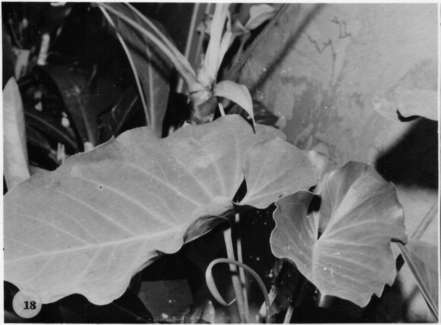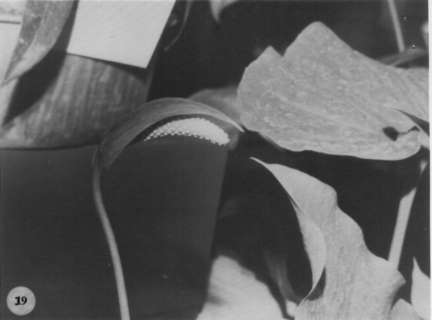





Ceiba 3: 103. 1952. TYPE: Nicaragua. Dept. of Jinotega: mountains cast of Jinotega, along trail to Cerro la Cruz, elev. 1,050-1,350 m. Standley 10255 (F, holotype; EAP, isotype).
Terrestrial; stems thick, to 4 cm diam., leaf cars 4 cm wide; roots sparse, descending, tan; cataphylls coriaceous, 4-12 cm long, caudate and piculate at apex, drying yellow (B & K Yellow 1/10), persisting as moderately coarse longitutinal fibers.
LEAVES erect-spreading; petioles 3-73 cm long, 5-8 mm diam., subterete,
shalowly and bluntly sulcate, sometimes merely flatened adaxially; geniculum
1.5-2.5 cm long; blades subcoriaceous, triangular-ovate to ovate, icuminate
at apex, deeply lobed al base, 14-51 ;m long, 8-36 cm wide, broadest at point
of xtiole attachment, the margin undulate; posterior lobes 5-18 cm long from
sinus to lip, the sinus hippocrepiform to triangular, acute to round at apex;
both surfaces matte to semiglossy, sometimes with punctiform or linear raphide
cells (more conspicuous on dry specimens); midrib raised above and below; basal
veins 5-6 pairs, the first and second free, the remaining coalesced 2.7-4 cm,
raised above and below; posterior rib turned up along the outer margin; primary
lateral veins 4-8 per side, departing midrib at 40°-55° angle, flat
to weakly raised above, raised below;
interprimary veins flat above, raised below; lesser veins scarcely
visible; collective vein arising from the first basal vein or one of the
primary lateral veins, 1-2.5 cm from margin, flat above, raised below.
INFLORESCENCE erect-spreading; peduncle 20-67 cm long, 3-6 mm diam., slightly curved near base of spadix, shorter to longer than leaves; spathe green (B & K Green 6/2.5), subcoriaceous, narrowly ovate or boat-shaped, 8-15 cm long, 2-5 cm wide, broadest just above middle, long-acuminate at apex, de-current and clasping at base. inserted at 65°-80° angle on peduncle, held behind and hooding spadix; spadix pale green (B & K Green 7/2.5), glaucous, 6.5-12 cm long. 5-8 mm diam. at base, 4-5 mm diam. at apex, slightly curved just below middle so that the tip turns down; flowers 4-lobed, 2-3 mm long. 2.5-3.5 mm wide, the sides jaggedly sigmoid: 4-5 flowers visible in the principal spiral, 5-10 flowers visible in the alternate spiral; tepals matte, densely and minutely papillate, with droplets, lateral tepals 1.5 mm wide, the inner margin convex: pistils emergent, bright green; stigma slitlike with blunt papillae and a large droplet for 3 or 4 days before first stamens emerge; stamens emerging very slowly in a complete sequence from base. held in tight circle around pistil just above the tepals; anthers pale yellow, slanting over pistil before opening, ca. 0.6 mm long, 1.1 mm wide; thecae ellipsoid, somewhat divaricate: pollen pale yellow, fading white.
INFRUCTESCENCE pendent, spathe persisting; berries obovoid-ellipsoid,
yellow to yellow-orange, 13-15 mm long. 9-11 mm wide;
pericarp thick, darker colored and lacking raphide cells near apex,
numerous granular raphide cells in the lower half; mesocarp juicy, fragrant,
sweet; seeds 1-2, semicircular to broadly ellipsoid, brown with numerous
minuie granular projections on surface, flattened. 8-9 mm long, 8-9 mm
wide, 3 mm thick, encased in a thin envelope. Figs. 18
and 19.
Anthurium beltianum is endemic to central Nicaragua in the departments
of Jinotega and Matagalpa at elevations of 1,000 to 1,500 m in premontane
wet forest life zones, on limestone outcrops. The species was named in
honor of the famous English naturalist Thomas Bell, author of the "The
Naturalist in Nicaragua." It is a member of section Calomystrium
and is recognized by its moderately thick, ovate-cordate leaves with an
obovate or hippocrepiform sinus, but especially by its semi-erect inflorescence
with the moderately short, tapered, pale green spadix directed downward
and by its lanceolate-elliptic to narrowly ovate spathe, which curves outward
forming a protective covering above the spadix.
Anthurium beltianum is similar to A.
cotobrusii, which has generally similar leaves and inflorescences
but does not have the hooded inflorescences of A. beltianum.
 |
 |
Map of Mesoamerican specimens with coordinates
Nicaragua Jinotega: 1000 m,, 7 Aug. 1977, Thomas B. Croat 43003
(MO).
Nicaragua Jinotega:, , Standley 10255 (F). Nicaragua Jinotega:, , Standley
10359 (F).
Nicaragua Jinotega:, , Standley 10883 (F). Nicaragua Jinotega:, , Williams
et al. 24733 (F, G).
Nicaragua Jinotega: 1400 m, 13.2N 85.55W, 7 May 1980, Stevens et al.
17029 (MO).
Nicaragua Matagalpa: 1400 m,, 27 Nov. 1977, Neill 3020 (MO).
Nicaragua Matagalpa: Cordillera Dariense, 1550 m,, 9 Apr. 1978, Neill
3452 (MO).
Nicaragua Matagalpa: Cordillera Central de Nicaragua, 1400 m,, 18 Jan.
1965, Williams et al. 27887 (MO).
Nicaragua Matagalpa: Valle Palcila, 1200-1300 m, 13.00N 85.56W, 20
Feb. 1981, Moreno 7039 (MO).
Nicaragua Matagalpa: 1360-1380 m, 13.2N 85.55W, 7 May 1980, Stevens
et al. 17081 (MO).
Nicaragua Matagalpa: 1380 m, 13.02N 85.55W, 2 julio 1980, P.P. Moreno
1056 (MO).
Nicaragua Matagalpa: 1380 m, 13.02N 85.55W, 2 julio 1980, P.P. Moreno
1057 (MO).